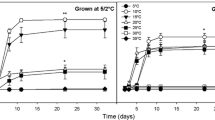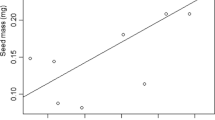Abstract
The seed size and number theories have been proposed to explain the advantages of having many small versus a few large seeds in plants. In particular, seed germination is predicted to be shaped by temperature, and may differ for small and large seeds. In this study, we experimentally test germination at different temperatures in 12 species of arid zone plants in the genus Frankenia L. that differ in seed mass. Seed mass was categorized as “smaller-seeded species” versus “larger-seeded species” for analysis (six species per category). Many of these species co-occur geographically and hence experience similar abiotic conditions (unpredictable rainfall, extremes in temperature, poor soil conditions). The results demonstrated differences in germination as a result of the temperature*seed mass(species) interaction effect. There were significant differences in germination rates across seed mass categories during the first eight days of germination. Germination rates were higher in the larger-seeded species than the smaller-seeded species. Smaller-seeded species had lower germination success but had higher germination rates at lower temperatures, and had a more stringent temperature as a germination cue. These findings are discussed in the context of life-history strategies in arid zone plants.


Similar content being viewed by others
References
Baker HG (1972) Seed weight in relation to environmental conditions in California. Ecology 53:997–1010
Barnsley B (1982) Frankeniaceae. In George AS (ed) Flora of Australia 8. Australian Government Publications, Canberra, pp 112–146
Baskin CC, Baskin JM (1988) Germination ecophysiology of herbaceous plant species in a temperate region. Amer J Bot 75:286–305
Becker LA (1999) SPSS course content – fall, 2000. Available at http://web.uccs.edu/lbecker/SPSS/content.htm. Accessed 4th October 2008
Bell DT (1999) Turner review no 1. The process of germination in Australian species. Austral J Bot 47:475–517
Bell DT, Plummer JA, Taylor SK (1993) Seed germination ecology in southwestern Western Australia. Bot Rev 59:24–53
Bell DT, Rokich DP, McChesney CJ, Plummer JA (1995) Effects of temperature, light and gibberellic acid on the germination of seeds of 43 species native to Western Australia. J Veg Sci 5:797–806
Brightmore D (1979) Biological flora of the British Isles. Frankenia laevis L. J Ecol 67:1097–1197
Brochmann C, Lobin W, Sinding P, Stabbetorp O (1995) Parallel ecoclinal evolution and taxonomy of Frankenia (Frankeniaceae) in the Cape Verde Islands, W. Africa. Nordic J Bot 15:603–623
Craigie AI (2007) Systematic studies of the Australian species of Frankenia L. (Frankeniaceae). PhD Thesis, Flinders University, Adelaide, Australia
Dytham C (2003) Choosing and using statistics: a biologist's guide. Ed. 2. Blackwell Publishing, Oxford
Easton LC (2008) Life history strategies of Australian species of the halophyte and arid zone genus Frankenia L. (Frankeniaceae). PhD Thesis, Flinders University, Adelaide, Australia
Easton LC, Kleindorfer S (2008) Germination in two Australian species of Frankenia L., F. serpyllifolia Lindl. and F. foliosa J.M. Black (Frankeniaceae) – effect of seed age, seed mass, light, and temperature. Trans Roy Soc S Austral 132:29–40
Easton LC, Kleindorfer S (in press) Effects of salinity levels and seed mass on germination in Australian species of Frankenia L. (Frankeniaceae). Environm Exp Bot
Elberse WT, Breman H (1990) Germination and establishment of Sahelian rangeland species. II. Effects of water availability. Oecologia 85:32–40
Facelli JM, Ladd B (1996) Germination requirements and responses to leaf litter of four species of eucalypt. Oecologia 107:441–445
Fenner M (1983) Relationships between seed weight, ash content and seedling growth in twenty four species of Compositae. New Phytol 95:697–706
Fenner M (1992) Environmental influences on seed size and composition. Hort Rev 13:183–213
Fenner M, Thompson M (2005) The ecology of seeds. Cambridge University Press, Cambridge
Frasier GW, Cox JR, Woolhiser DA (1985) Emergence and survival responses of seven grasses for six wet-dry sequences. J Range Managem 38:372–377
Freas KE, Kemp PR (1983) Some relationships between environmental reliability and seed dormancy in desert annual plants. J Ecol 71:211–217
Geritz SAH, van der Meijden E, Metz JJ (1999) Evolutionary dynamics of seed size and seedling competitive ability. Theor Populat Biol 55:324–343
Gurvich DE, Enrico L, Funes G, Zak MR (2004) Seed mass, seed production, germination and seedling traits in two phenological types of Bidens pilosa (Asteraceae). Austral J Bot 52:647–652
Harper JL, Lovell PH, Moore KG (1970) The shapes and sizes of seeds. Annual Rev Ecol Syst 1:27–355
Hastwell GT, Facelli JM (2003) Differing effects of shade-induced facilitation on growth and survival during the establishment of a chenopod shrub. J Ecol 91:941–950
Jurado E, Westoby M (1992a) Germination biology of selected central Australian plants. Austral J Ecol 17:341–348
Jurado E, Westoby M (1992b) Seedling growth in relation to seed size among species of arid Australia. J Ecol 80:407–416
Keeley JE (1991) Seed germination and life history syndromes in the Californian Chaparral. Bot Rev 57:81–116
Lamont BB, Witkowski ETF (1995) A test for lottery recruitment among four Banksia species based on their demography and biological attributes. Oecologia 101:299–308
Leishman MJ, Wright IJ, Moles AT, Westoby M (2000) The evolutionary ecology of seed size. In Fenner M (ed) Seeds, the ecology of regeneration in plant communities. Ed. 2. CABI Publishing, Wallingford, pp 31–58
Lovett Doust J (1989) Plant reproductive strategies and resource allocation. Trends Ecol Evol 4:230–234
Marone L, Horno ME, Solar RGD (2000) Post-dispersal fate of seeds in the Monte desert of Argentina: patterns of germination in successive wet and dry years. J Ecol 88:940–949
Marshall DL (1986) Effects of seed size on seedling success in three species of Sesbania (Fabaceae). Amer J Bot 73:457–464
Maun MA, Lapierre J (1986) Effects of burial by sand on seed germination and seedling emergence of four dune species. Amer J Bot 73:450–455
Mazer SJ (1990) Seed mass of Indiana Dune genera and families: taxonomic and ecological correlates. Evol Ecol 4:26–357
Meyer SE, Carlson SL, Garvin SC (1998) Seed germination regulation and field seed bank carryover in shadescale (Atriplex confertifolia: Chenopodiaceae). J Arid Environm 38:255–267
Milberg P, Lamont BB (1997) Seed/cotyledon size and nutrient content play a major role in early performance of species on nutrient poor soils. New Phytol 137:665–672
Milberg P, Anderson L, Elfverson C, Regnér S (1996) Germination characteristics of seeds differing in mass. Seed Sci Res 6:191–197
Mott JJ (1972) Germination studies on some annual species from an arid region of Western Australia. J Ecol 60:293–304
Pérez-García F, González-Benito ME (2006) Seed germination of five Heliathemum species: effect of temperature and pre-sowing treatments. J Arid Environm 65:688–693
Ramirez-Padilla CA, Valverde T (2005) Germination responses of three congeneric cactus species (Neobuxbaumia) with differing degrees of rarity. J Arid Environ 61:333–343
Rees M, Westoby M (1997) Game-theoretical evolution of seed mass in multi-species ecological model. Oikos 78:116–126
Richards MB, Lamont BB (1996) Post-fire mortality and water relations of three congeneric shrub species under extreme water stress – a trade-off with fecundity? Oecologia 107:53–60
Roffe DA (2002) Life history evolution. Sinauer Associates, Sunderland
Salisbury E (1974) Seed size and mass in relation to environment. Proc Roy Soc London B 186:83–88
Silvertown J (1981) Seed size, life span and germination date as coadapted features of plant life history. Amer Naturalist 118:860–864
Smith CC, Fretwell SD (1974) The optimal balance between size and number of offspring. Amer Naturalist 108:499–506
SPSS Inc. (2006) SPSS Programming & data management: a guide for SPSS & SAS users, Ed. 3. SPSS Inc., Chicago
Stock WD, Pate JS, Delfs J (1990) Influences on seed size and quality in seedling development under low nutrient conditions in five Australian and South African members of Proteaceae. J Ecol 78:1005–1020
Summerhayes VS (1930) A revision of the Australian species of Frankenia. Linn J Bot 48:337–387
Thompson K, Grime JP (1983) A comparative study of germinating responses to diurnally fluctuating temperatures. J Appl Ecol 20:141–156
Trudgill DL, Squire GR, Thompson K (2000) A thermal basis for comparing the germination requirements of some British herbaceous plants. New Phytol 145:107–114
Van Tooren BF, Pons TL (1988) Effects of temperature and light on the germination in chalk grassland species. Funct Ecol 2:303–310
Venable DL, Dyreson E, Piñero D, Becerra JX (1998) Seed morphometrics and adaptive geographic differentiation. Evolution 52:344–354
Verger P, Rengelink R, Copal A, Ouberg NJ (2003) The interacting effects of genetic variation, habitat quality and population size on performance of Succisa pratensis. J Ecol 91:18–26
Washitani I, Masuda M (1990) A comparative study of the germination characteristics of seeds from a moist tall grassland community. Funct Ecol 4:543–557
Westoby M, Falster DS, Moles AT, Vesk PA, Wright IJ (2002) Plant ecological strategies: some leading dimensions of variation between species. Annual Rev Ecol Syst 33:125–159
Wiens D (1984) Ovule survivorship, brood size, life history, breeding systems, and reproductive success in plants. Oecologia 64:47–53
Wrigley JW, Fagg M (2003) Australian native plants: cultivation, use in landscaping, and propagation. Ed. 2. Reed New Holland Publishing, Australia
Wulff RD (1986) Seed size variation in Desmodium paniculatum. II. Effects on seedling growth and physiological performance. J Ecol 74:99–114
Zubrinich TM (1990) An experimental examination of factors influencing zonation of the halophyte plant species, Frankenia pauciflora in a Goolwa salt marsh. BSc. Honours thesis, Flinders University, Adelaide, South Australia
Acknowledgements
Sincere thanks to Drs M. Whalen and D. Mackay for giving LCE the opportunity to study this interesting plant genus, and for their guidance during the initial stages of this project. Diane Allen, Tom Chapman, Andrew Craigie, Rick Davies, Gordon Easton, Gwen Easton, Duncan Mackay, Mike McLeish and Dean Nicolle assisted with seed collection. Statistical analysis support was given by Kylie Lange. Diane Allen assisted with the weighing of seeds. Thanks to D. E. Albrecht for providing localities for F. cordata. Seeds were collected with permission in SA (DEHAA permit #Z24947 3), NT (Parks and Wildlife Commission permit # 20216), and WA (CALM). This study was funded by: Australian Flora Foundation, Mark Mitchell Research Foundation, Wildlife Conservation Fund, Native Vegetation Fund, the Flinders University Post-graduate Development Program, and the Nature Foundation SA Postgraduate Scholarship Grant. It is part of a PhD thesis by LCE at Flinders University, Adelaide, South Australia.
Author information
Authors and Affiliations
Corresponding author
Rights and permissions
About this article
Cite this article
Easton, L.C., Kleindorfer, S. Interaction Effects of Seed Mass and Temperature on Germination in Australian Species of Frankenia (Frankeniaceae). Folia Geobot 43, 383–396 (2008). https://doi.org/10.1007/s12224-008-9021-x
Received:
Revised:
Accepted:
Published:
Issue Date:
DOI: https://doi.org/10.1007/s12224-008-9021-x




